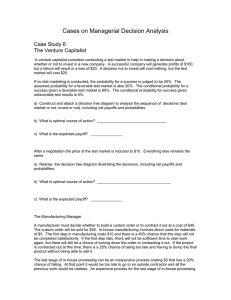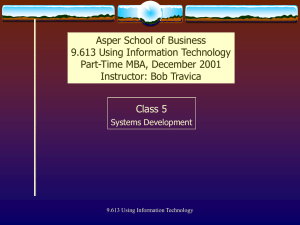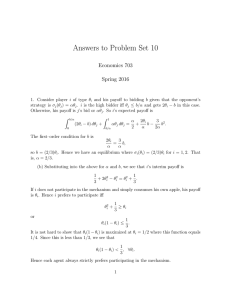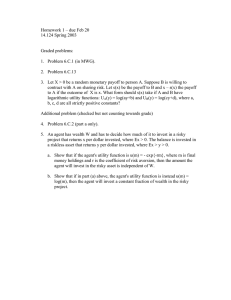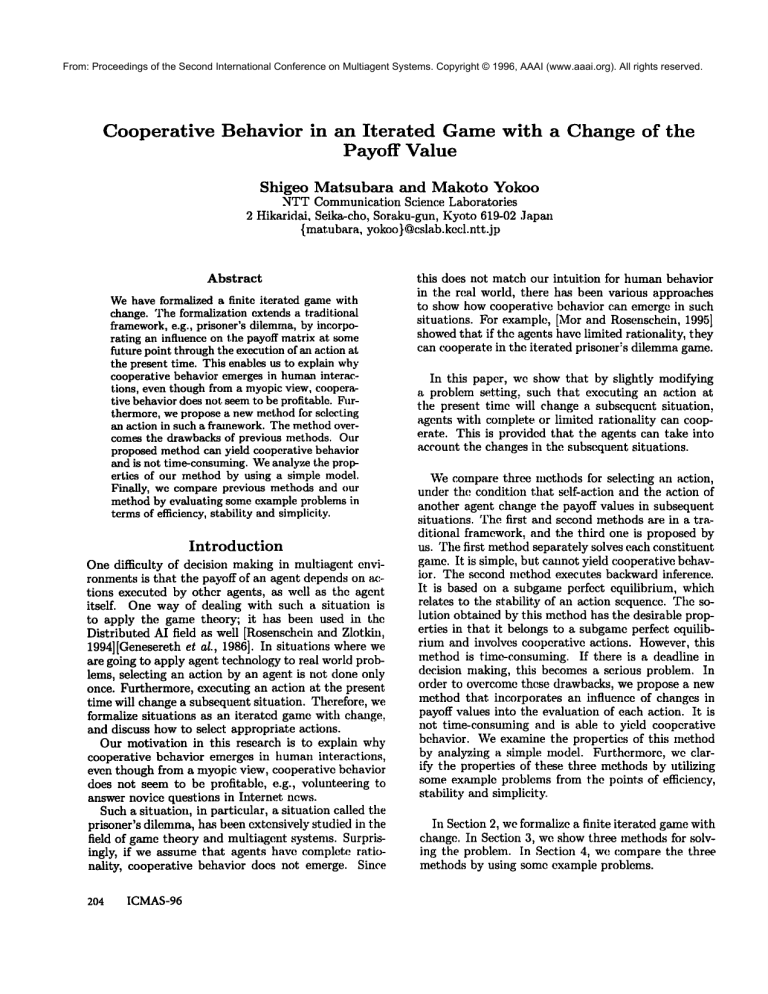
From: Proceedings of the Second International Conference on Multiagent Systems. Copyright © 1996, AAAI (www.aaai.org). All rights reserved.
Cooperative
Behavior
in an Iterated
Game with a Change of the
Payoff Value
Shigeo
Matsubara
and Makoto
Yokoo
NTT Communication Science Laboratories
2 Hikaridai, Seika~cho, Soraku-gun, Kyoto 619-02 Japan
{mat.ubara, yokoo }@cslab.kccl.ntt.jp
Abstract
Wehave formalized a finite iterated game with
change. The formalization extends a traditional
framework,e.g., prisoner’s dilemma,by incorporating an influence on the payoff matrix at some
future point throughthe executionof an action at
the present time. This enables us to explain why
cooperative behavior emerges in humaninteractions, even though from a myopicview, cooperative behaviordoes not seemto be profitable. ~xrthermore, we propose a new methodfor selecting
an action in such a framework.The methodovercomes the drawbacks of previous methods. Our
proposed methodcan yield cooperative behavior
and is not time-consuming.~Veanalyze the propertics of our method by using a simple model.
Finally, wc compare previous methods and our
method by evaluating some example problems in
termsof efficiency, stability andsimplicity.
Introduction
One difficulty of decision makingin mult.iagent environments is that the payoff of an agent depends on actions executed by other agents, as well as the agent
itself. One way of dealing with such a situation is
to apply the game theory; it has been used in the
Distributed AI field as well [Rosensc~ein and Zlotkin,
1994][Genesereth et al., 1986]. In situations where we
are going to apply agent technology to real world problems, selecting an action by an agent is not done only
once. Furthermore, executing an action at the present.
time will change a subsequent situation. Therefore, we
formalize situations as an iterated game with chmlge,
and discuss howto select appropriate actions.
Our motivation in this research is to explain why
cooperative behavior emerges in humaninteractions,
even though from a myopic view, cooperative behavior
does not seem to be profitable, e.g., vohmteering to
answer novice questions in Internet news.
Such a situation, in particular, a situation called the
prisoner’s dilemma, has been extensively studied in the
field of game theory and multi~gcnt systems. Surprisingly, if we assume that agents have complete rationality, cooperative behavior does not emerge. Since
204
ICMAS-96
this does not match our intuition for humanbehavior
in the real world, there has been various approaches
to show how cooperative behavior can emerge in such
situations. For example, [Mor and Rosensehein, 1995]
showedthat if the agents have limited rationality, they
can cooperate in the iterated prisoner:s dilemmagame.
In thispaper,we showthatby slightly
modifying
a problemsetting,
suchthatexecuting
an actionat
thepresenttimewillchangea subsequent
situation,
agentswithcomplete
or limited
rationality
cancooperate.Thisis provided
thattheagentscantakeinto
account
thechanges
in thesubsequent
situations.
Wecompare three methods for selecting an action,
under the condition that self-action and the action of
another agent change the payoff values in subsequent
situations. The first and second methods are in a traditional framework, and the third one is proposed by
us. The first methodseparately solves each constituent
game. It is simple, but cannot yield cooperative, behavior. The second method e~xecutes backward inference.
It is based on a subgame perfect equilibrium, which
relates to the stability of an action sequence. The solution obtained by this methodhas the desirable properties in that it belongs to a subgamcperfect equilibrium and involves cooperative actions. However, this
method is tim~consuming. If there is a de,~lline in
decision making, this becomes a ~rious problem. In
order to overcome these drttwbacks, we propose a new
method that incorporates an influence of changes in
payoff values into the evaluation of each action. It is
not time-consuming and is able to yield coopcrative
behavior. Weexamine the properties of this nmthod
by analyzing a simple model. Furthermore, wc clarify the properties of these three methods by utilizing
some exmnple problems from the points of efficiency,
stability and simplicity.
In Section 2, we formalize a finite iterated gamewith
change. In Section 3, we show three methods for solving the problem. In Section 4, we compare the three
methods by using somc example problems.
From: Proceedings
Conference on Multiagent Systems. Copyright © 1996, AAAI (www.aaai.org). All rights reserved.
Iteratedof the Second
GameInternational
with Change
In this section, we make clear what problem we will
tackle. Formalization of the problem is based on the
game theory. Wepoint out the necessity for incorporating the influence on subsequent games, which is
done by executing actions in the present game, into a
traditional framework.
(a) A Payoff Matrix
Formalization of a Finite Iterated Game
without Change
One of our goals is to find an effective way for an autonomous agent to select an appropriate action under
the condition that the agent’s payoff depends on both
his action and the action of another agent. The difficulty of the problem is that the agent cannot control
the behavior of another agent. Wehave to consider
whatactionis concluded
onlyusingthefactthatall
agents
arerational.
In thispaper,
we limitan interaction
between
agents
to a two-agent
relation.
If morethantwoagentsexist
in theworld,
we treattheirinteractions
as theaccumulation
of independent
two-agent
relations.
A game
is defined
by thetupleof agents,
actions
andpayoff
matrices.
A setof agents
isrepresented
as follows.
Agent = {agen.th agent2}
A setof actions
is represented
as follows.
Action = {Action1, Action2}
Action1 = {al, a2,-.., ak}
Action2 = {bl,b2,-.., bt }
agent1 can execute one of the actions ai, and agent2
can execute one of the actions bj. Each agent gets
paid off mad the value is determined by the pair of
actions ai and bj. A payoff consists of fl(ai,bj) and
fz(ai, b#). Whenagent1 executes a+ and agentz executes bj, agentt receives fl (a+, bj) and agentz receives
f2(a~,
bj).
Weassume the following.
¯ Each agent is rational, i.e., each agent executes an
action expected to maximize his payoff.
¯ There is no agreement by which an agent has to
select an action. This is called a non-cooperative
game.
¯ Each agent knowsthe other agent’s payoffvalue, i.e.,
pa~)ff values are commonknowledge.
Here, we define a two-player game, G.
Definition: A two-player game G is represented as
the tuple of Agent, Action, and Payoff. It is the seties of getting a task, selecting an action and getting
paid off.
A game is represented by a bimatrix (a payoff matrix) or an extensive form. An exampleof a bimatrix is
shownin Figure l(a). In Figure l(a), lower left. values
vlij are for agent1 and upper right values v2~# are for
agent2. The extensive form of the game is shown in
Figurel(b).
~~
(vlm,
v212)
(b) An Extensive Form
Figure 1: GameRepresentations
In general, action selection is not done only once. We
consider the case where a task is periodically given to
each agent. Whenthe task is given, each agent selects
an action for the task and gets paid off. This process
is repeated N times. N is given at the beginning of
the whole game.
Weassume the following.
¯ Each agent has a complete memoryof past games.
Here, we define a two-player finite iterated gamer.
Definition: A two-player finite iterated gameF is represented by the tuple of Agent, Action, Payoff, History, and N. It is a series for the two-player game,
G. History is a memory of the past games, and N
stands for the numberof iterations.
Formalization
of a Finite
Iterated
Game
with Change
The traditional framework mainly deals with r on the
condition that the payoff matrix in G does not change
while playing r. However, this is not always appropriate. Executing an action causes a change in state,
and it effects the payoff values. For instance, let’s suppose that tasks for transporting goods axe given to two
agents several times. Whenan agent encounters aa obstacle during transportation, he can either go around
the obstacle and lea,~ it or removeit and go straight. If
the first detector goes around the obstacle, the other
agent has to pay an extra cost for the detour when
he passes through there. On the other hand, if the
first detector removesthe obstacle, the detour cost no
longer exists. Therefore, if it is possible to predict an
influence by executing an action, it is necessary to deal
with the change of payoff values in order to examine
the cooperative behavior. In this paper, we only assume the change of payoff values; other factors do not
change.
Wedefine a two-player iterated game with change
Fc as follows.
Matsubara 205
From: Proceedings of the Second International Conference on Multiagent Systems. Copyright © 1996, AAAI (www.aaai.org). All rights reserved.
Definition: A two-player iterated game with change
rc is represented as the tuple of Agent, Action, Payoff, History, N, and ChangeRules of Payoff. It is
a two-player iterated game with changes in payoff
matrix values.
agent
2
The Change Rules of Payoff is represented by the
difference between payoff values in the next game and
in the present game. A description of effects by actions
is another of the ChangeRules of Payoff. By calculating the new state and calculating the worth and cost of
attaining a task in the state, we can obtain new payoff
values.
It is true that we can formalize a problem without
an explicit description of change by looking at the entire game in advance. However, it is not realistic to
enumerate and maintain all sequences of actions if the
number of actions and/or iterations increases. Therefore, we need an explicit description of change.
Our claim is that cooperative behavior yields from
existence of a relation between the present game and
subsequent games. In the next section, we will illustrate our claim.
An Action
Selection
In this section, we describe how to select an appropriate action. First, we explain the concept of the Nash
equilibrium point. Then, we show three methods for
selecting an action.
Solutions
in a Two-player
Game
What action should an agent select? The concept of
the Nash equilibrium point suggests one solution for
this question. A Nash equilibrium point is defined ms
follows.
Definition: If fl(a~,b~) = maxa,~actio~l fl(a~,b~)
and s2~ ~, j] = ma~xbjEAetion2f2(a~,bj)
, then
(a~, b~) is a Nash equilibrium point.
If agent2 selects an action b3 belonging to a Nash
equilibrium point, agent1 has no incentive to deviate
from selecting an action a~ al~ belonging to it. A Nash
equilibrium point is not necessarily Pareto optimal, but
it is stable. If both agents are rational, they will select
actions belonging to a Nash equilibrium point.
If there is more than one Nash equilibrium point,
both agents select the equilibrium point that jointly
dominates the other equilibrium points. If there is not
"such an equilibrium point, more constraints are needed
to select a unique solution.
Think Only of the Present
In a two-player iterated game with change Fc, a simple
way to select an action is to separately deal with each
game.
Think Only of the Present
Method (TPM):
Find Nash equilibrium points for the present game,
G. Any change of payoff values is not included in the
206
ICMAS-96
agent2
(C,C)
agent2 /
c
¯ -c
53 3
~ D 6 ’4 4
C 6 6 47
D 74 "~
agent
2
:,li,)0o,.
( the first
c
game\
(D,D)
D 6
\
5I
5
3
6
3
4
4
agent
2
¢;
O~
¢0
c
5
5
6
3
D:6
(b) the secondgame
Figure 2: An Example Problem
evaluation of the action. If a unique one exists, execute the action belonging to the equilibrium point.
If there is more than one equilibrium point, select
the dominant equilibrium point. If a dominant one
does not exist, select one at randomand execute it.
If there is no equilibrium point, execute an arbitrary
action.
One drawback of this method is missing an action
that has a lower payoff in the prescnt, but a higher
payoff in the future. Let’s assume the iterated game
shown in Figure 2. Action C stands for a coopcrarive action and action D stands for a non-cooperative
action. The number of iterations is two. Figure 2(a)
shows the first game and Figure 2(b) shows the second game, which is obtained by using Change Rules
of Payoff and corresponds to each pair of actions in
the first game. These types of games are called a prisoner’s dilemma, where v121 > Vlll > v122 > vl12,
v212
> v211
> v222
> v221,
2 x Vlll>
vl2i
+ v112,
and 2 x v211 > v212 +v221. TPMgives us the solution
(D,D) in the first game and (D,D) in the second game,
i.e., both agents always behave non-cooperatively. The
total payoff for each is 9. It turns out that in the next
subsection, there is another solution belonging to an
equilibrium point that dominates the solution obtained
by TPM.
Backward Inference
Howcan we find a sequence of actions that brings
a higher payoff in tim future? Such a sequence is
obtained by backward inference. Backward inference
From: Proceedings of the Second International Conference on Multiagent Systems. Copyright © 1996, AAAI (www.aaai.org). All rights reserved.
agent
2
C 88 69
D9
6
.--clS
=_ 5 3
6
c~,~.3
3. findanequilibrium
pointontheaccumulated D 63~
payoff
matrix
1. findanequilibrium
point
in thesecond
game
Figure3: Processfor FindingAn ActionSequence
by
BIM
givesusa solution
belonging
to a subgarne
perfect
equilibrium
point.A subgame
perfect
equilibrium
pointis
a pairof actionsequences
whereby
eachagentdoesnot
intend
atanypointtochange
thelatter
partofthesequenceafteran action.
If a solution
foran r~-times
iterated
gamebelongsto a subgameperfectequilibriumpoint,
thesolution
forthelast(n - 1) partof the
gamehas to belongto a subgameperfectequilibrium
point.
A different
backward
inference
is usedin [Kraus
et aL,1995]forotherproblems.
Thebackward
inference
methodis as follows.
Backward Inference Method (BIM): Calculate
the payoff matrix in the last game by using Change
Rules of Payoff. Find a Nash equilibrium point for
each last game. By adding the value of each equilibrium point in the last game to the payoff values of
the (N - 1)th preceeding game, get an accumulated
payoff matrix in the (N - 1)th game. Find a Nash
equilibrium point on the accumulated payoff matrix.
Repeat the procedure until the calculation reaches
the first game. Whenthis occurs, select the action
belonging to a Nash equilibrium point in the payoff matrix accumulated from the last to first games.
Select the action already obtained in the succeeding game. Whenthere is no Nash equilibrium point
or there is more than one equilibrium point in the
game, deal with it like TPM.
Wego back to the above example problem. Figure 3
shows the calculation process by BIM. BIMfirst finds
equilibrium
pointsin thesecondgame.By addingeach
payoff
valuebelonging
to an equilibrium
pointto each
corresponding
valuein thepayoffmatrixof thefirst
game,we get an accumulated
payoffmatrix.It containsthesumof payoffvaluesobtained
fromthewhole
game.BIMfindsequilibrium
pointson thatpayoffmatrix.BIMgivesus thesolution
(C,C)in thefirstgame
and(D,D)in thesecondgame.The totalpayoffvalue
foreachis 12.Eachagentdoesnotintendto execute
a non-cooperative
actionin thefirstgamebecause
it
bringsa higherpayoffin thefirstgame,butresults
in a lowerpayoff,
11,at theendof thesecondgame.
The solutionobtainedby BIM belongsto a subgame
perfect
equilibrium
point.
In a finite
iterated
game,thegametheory
states
that
rationality
doesnotnecessarily
yieldcooperative
behavior.
In ourexample,
rationality
yieldscooperative
behavior.
Thatis,theexpectation
of a higher
payoff
in
a future game yields cooperative behavior. Therefore,
in order to understand cooperation existing in the real
world, we have to deal with the relations between the
present game and future games.
A drawbackof this methodis that its calculation is
time-consuming. The computation cost of this method
is O(k x/)Iv-1 whereas the computation cost of TPM
is O(N). This becomes serious if an agent has to execute an action before a deadline.
Look Ahead
We proposea new methodin orderto overcomethe
drawbacksof TPM and BIM. Our requestsfor the
methodarethatan agentcanselecthisactionwhile
takingchanges
of thegamesintoaccount
andthatthe
methodis nottime-consuming.
We definetheutility
ul,u~.,andan agentselects
anaction
according
to the
utility.
Definition: Utility for agentx: ul(ai, bj) = (1 -w)
vl~.j + wxdiffl(a~,
bj)
wherew is theweighting
factor,
diffx(ai,
bj)is the
average
difference
between
thepayoffvaluein the
succeeding
gameandthatin thepresent
game.It is
defined
asfollows:
diffl(ai, bj)= ~,,j(vl:# -vl,#)/(l x k)
where vlij is a payoff value in the present game and
vl~j is a payoff value in the game after executing a
pair of actions a~, bj.
The utility for agent2 is defined in the same way.
Look Ahead Method (LAM): Calculate
the utility u and obtain a utility matrix in the present game.
Find a Nash equilibrium point on the utility matrix.
Select an action belonging to the equilibrium point.
Whenthere is no Nash equilibrium point or there is
more than one equilibrium point in the game, deal
with it like TPM.
The aim of this method is to incorporate the influence of changes in the payoff matrix into the action
evaluation criterion.
Matsubara 207
From: Proceedings of the Second International Conference on Multiagent Systems. Copyright © 1996, AAAI (www.aaai.org). All rights reserved.
TPM
[
BIM
LAM
C
O(N)] O((k× 0
D
TableI: Computational
Costsof the ThreeMethods
We go back to the aboveexampleproblem.When
w = 0.6,a utility
for(C,C)is calculated
asfollows.
u,(C,C) (1 - 0 .6 ) x 6 +0.6 x 2 = 3.
When w = 0.6, LAMgives us the solution (C,C)
in both the first and second games. LAMtreats the
second game as the game with change. The total payoff
value for each is 14. This solution does not belong to an
equilibrium point. However, if both agents know that
the other agent is using LAM,they find that executing
a non-cooperative action in the first game decreases
each total payoff. Thus, an agent prefers cooperative
behavior in this situation.
Another way for selecting actions by incorporating
future payoff into the evaluation is reinforcement learning, such as Q-learning [Watkins and Dayan, 1992]. It
is effective if an agent is unable to modelthe world and
the other agent. However, if the agent knows how to
change the world and that the other agent is rational,
LAMis effective with respect to speed and memory
capacity. LAMdoes not need a learning period and
LAMdoes not need to maintain Q-values.
The computational costs of the three methods are
shown in Table 1. If there are some constraints on
how to change the payoff values, BIM’s computational
cost maybe reduced as follows. (1) If there is a limit
the amount of accumulated changes, some branches of
an expanding tree of payoff matrices are cut by checking the maximumor minimumvalues accumulated in
remaining games. (2) If a way of changing the payoff values does not depend on the previous action se-.
quence, we can obtain some criteria for selecting actions without exhaustive calculation. However,for the
worst case, BIM’scomputational cost is still exponential to the numberof iterations.
Evaluation
by using a simple model
By using a simple model, we examine when cooperative
behavior emerges. Suppose two agents play the game
shownin Figure 4. vl~c is the payoff value of agentl
for (C,C) in the nth game. We assume each payoff
matrix is symmetrical, i.e., vl~c= V2cc," VlcDn =
,
n = V2CD,VlDD
V2Dc,VlDc
n
n = V2~D. C~n, ~n, 7n are
thechangeof payoffvaluesfromthenthgameto tlte
(n+ l)thgamefor (C,C),{(C,D),(D,C)},
and (D,D),
respectively.
WhenBIM’s calculation reaches the n from the last
game (n -- N), holding the following inequalities are
requirements for (C,C) to be selected.
An+l ~
(vlZ’c +"’1,CC’ >
(vl~c +’q,cc,
~"+*~ >
208 ICMAS-96
(VI~c’+ "’1,1)C1
("15D
+ "’I,DD,
’4n’1"1~
An+l
(1)
(2)
Figure 4: A Payoff Matrix in the nth Game
An+l
I,CCis an accumulated payoff value for agent, from
the (n + 1)th game to the Nth game, as (C,C) is
cuted in the nth game.
For simplicity, we assume that a way of changing
payoff values does not depend on the previous action
sequence. As such, for whatever action is selected in
the nth game, an action sequence after the (n + 1)th
game obtained by BIMks uniquely detcrminc~t, since
the relations amongpayoff values in each game do not
change. Therefore, we obtain the following equations.
An+l
I,CC
A~+t
l,CC
--
An+l
"’l,OC
_An+*
I,DD
= (N - n)(~n - (N - n)/~n
= (N-n)an-(N.-n)%
Since we assume that all pa)x~ff values in each ganm
change equally, we obtain the following equations.
vl~. c-vl~c
= vlbcvlbc
,,1~c - vl~m = vlL. c -.vl})
o
The following inequalities are obtained from (1),(2)
by using the above four equations.
(N --- n)(Oen - fin) > vlbc - vlbc
(a)
( Ar -C n)(a,, - 7n) > VlbD - t’l~.
(4)
These inequalities elucidate the following about
emergence of cooperative behavior.
¯ As remaining games become longer, the more t:ooperative actions emerge.
¯ As a future payoff through a cooperative action becomes larger, the more cooperative actions emerge.
¯ As an immediate payoff from a non-cooperative action becomes smaller, the more cooperative actions
emerge.
Next, we examine the relation between the correctness of action selection and the weighting factor, w.
In the nth game, LAMevaluates the following inequalities.
(1 --- w)vl’~c + woln >
(1 -w)vl~: C +wan >
(1 - w)vl’~o + wfln
(1 - w)vl’~) o + w%
Weobtain the following.
>
- ")’,,- ,,1be+,,lbo),,,>
(c,. - l#n - vlbc + vl toc)W
- v1.c (s)
(6)
From: Proceedings of the Second International Conference on Multiagent Systems. Copyright
© 1996,
AAAITPM
(www.aaai.org).
All rights reserved.
Number
of
BIM LAM
~-~.25
z
~s
Pn’-’Y.
o~
.c_s
I
i
correct
mistake
i
:..::.:"
:.:.:::::"
I
¯ !!!,. ::
!i!iL!!i
ii!L
EL
Litii!Li
0
0
0.6
0.8
0.9
1
weighting
factorw
LAM
can select correct actions in shaded regions, but
LAM
makes a mistake in non-shaded regions.
Figure 5: Relation between the weighting factor and
the length of the remaining games
c
C
D
6
D
(a,,b~) d(tf(o.,,
(c,c) (+0.2,+0.2)
5
(C, O) (-0.1,-0.1)
(D,C) (-0.1,-0.1)
(m,D)
(0.0,
0.0)
4
6
4
7
7
5
The maximum
accumulated value of change is 2.0, and
the minimumaccumulated value of change is -2.0.
Figure6: A Prisoner’s
DilemmawithChangesin the
PayoffValues
In orderforthesolution
obtained
by LAMto equal
thesolution
obtained
by BIM,it is necessary
to either
simultaneously
maintain
or notmaintain
theaboveinequalities
(3),(4),(5),
and
The relation
betweenw andN - n is shownin Figure 5 for ~, -/~n= 0.25,/~,= 7,,vi]9
c - vl~c =
vl~c- vllo = 1. If w = 0.6, LAM makesa mistake
in selecting
aa actionwhenN-n> 4 because
it underestimates
thefuturepayoff.If w = 0.9,LAlVlmakes
a mistakewhen N - n < 4 becauseit overestimates
thefuturepayoff.The appropriateness
of w in each
game decides whether or not LAMis able to select the
correct actions.
Case Analysis
In this section, we apply the three methods to three
problems and evaluate the properties of these methods.
Case 1
Weshow that incorporating the influence of game
changes into the evaluation of actions yields cooperative behavior. Figure 6 shows the problem. There
are two agents in the environment. A task is given to
each agent 14 times. The payoff values in Figure 6 are
iterations
8
0.07
10
0.07
12
0.07
14
0.07
0.22
2.46
39.52
639.51
0.07
0.07
0.07
0.07
Table2: CPUTimesforthe ThreeMethods
(unit:[s])
initial values, which are calculated from the worth of
the task and the cost. Each agent has two ways of attaining the task. One is to cooperate with the other
agent, and the other is to be non-cooperative. Figure
6 also represents the change of payoff values. For instance, if both agents execute cooperative actions, the
payoff value increases by 0.2 for each. The upper and
lower limits of accumulated changes are 2.0 and -2.0,
respectively.
We evaluated the performance of each method by
the average payoff value. In TPM,the agent executed
no cooperative actions. In BIM, the agent executed
cooperative actions between the first game and the
9th game and non-cooperative actions in the remaining
games. In LAM(w = 0.95), the agent always executed
cooperative actions.
Figures 7(a),(b),(c)
show results when the
agent uses TPM, BIM, and LAM,respectively.
The
x-axis represents the progress of the game and the yaxis represents the average payoff value. Each point in
Figure 7 shows the average payoff value at that time.
Figure 7(b) tells us that the action sequence obtained
by BIMfinally dominates the other two methods. It
belongs to the subgamcperfect equilibrium point, i.e.,
if the agent knows that the other agent is using BIM,
a deviation from the sequence obtained by BIMdecreases his average payoff value. Figure 7(c) shows
that the action sequence obtained by LAMfinally dominates thatof TPM.It doesnotbelongto an equilibriumpoint.However,
if an agentknowsthattheother
agentis usingLAMandthevalueof weighting
factor
w, he understands
thathe shoulduse LAMinsteadof
TPM.
Thedrawback
of TPMis thatit doesnotyieldcooperative
behavior.
Therefore,
TPM bringsa considerablyloweraveragepayoffin comparison
withBIM
and LAM.The drawbackof BIM is that it is timeconsuming.
CPU timesare shownin Table2. If the
numberof iterations
increases,
BIMcannotsolvethe
problemin a reasonable
time.In thissituation,
LAM
becomesusefulthanBIM.
Case 2
Wewill solve a problem that is the same as in Case 1,
except for change rules of payoff values. The payoff
value increases by 0.4 for (C,C), (C,D), and (D,C)
and decreases by 0.4 for (D,D). In this game, cooperMatsubara
209
From: Proceedings of the Second International Conference on Multiagent Systems. Copyright © 1996, AAAI (www.aaai.org). All rights reserved.
8
8
8
7 -
is ..............
5_=>o
&s
gs
~5-
I 0
,
,
,
,
,
4 6 8 10 12
Progress of the Game
0
14
0
(a) other agentis using "rPM
TPM
BIM
Q LAM
1 -
I t
2
0
4.
8,3E
.m
,~2 -
2 -
--e-
~ ~ ,
~ ~ t
2 4 6 8 10 12
Progress of the Game
I
2
0
14
0
(b) other agentis using BIM
I
I
I
I
i
4 6 8 10 12
Progress of the Game
14
(c) ohter agentis using LAM
Figure 7: Results by the three methods: 1
8
8
8
, !><::::::’ :><::::::
®
28
>
5
},
},_
p-
~:~3 -
1 0
0
}:
I
I
I
I
I
4 6 8 10 12
Progress of the Game
(a) other agent is using TPM
0
14
0
I
p-
~2 -
I I
2
-e--
TPM
BIM
LAM
1 I
2
I
I
I
I
I
4 6 8 10 12
Progress of the Game
I
2
0
14
0
I
!
I
I
I
4 a 8 10 12
Progress of the Game
14
(c) ohter agent is using LAM
(b) other agent is using BIM
Figure 8: Results by the three methods: 2
ative behavior, regardless of the method used by the
other agent, always brings a favorable situation in the
subsequent game.
Figure 8 shows the results. Figure 8 (a) shows that
the average payoff value by BIMfinally exceeds that
by TPM.In this game, even if the agent does not know
the method used by the other agent, he is motivated
to execute a cooperative action. Aa action sequence
obtained by BIMin Case 2 has stronger stability than
that in Case 1.
Case 3
The third problem is shown in Figure 9. Each agent
alternatively takes the initiative.
An agent who has
the initiative determines whether he will solve the task
alone or ask the other agent for someinformation useful
for solving the problem. Whenthe other agent is asked
for information, he determines whether he will give his
information to the agent or ignore the request. Each
agent soh, es a task seven times.
In LAM,as w increases, the more cooperative an
agent’s behavior becomes. Figure 10 shows the results
for when the agent who had the initiative in odd num210
ICMAS-96
turn:
agent1 -).
C:
agent2 =
(fl,f2)
(3,-2)
query/,~
_~~
I-1
,-1)
-l~
D: ~tl
do by °neself-’~"~’O,
(a.~,b/)
diff(al,bj)
CO,C) (o.o,+o.4)
(C, D) (o.o,-0.4)
(D,,) (o.o,-o..t)
=
agent2 ->" agent1 (fl,f2)
~(-2,3)
~1-1,-1)
D: doby oneself""~ (-1,0)
(ai, bj) diff(a~,bj)
(c,c) (+o.4, o.o)
(C,D)(-0.4,0.0)
(,, D)(-0.4,0.0)
The maximum
accumulatedvalue of difference is 0.8, and
the minimumaccumulatedvalue of difference is -0.8.
Figure 9: An Alternate
Query and Answer Problem
From: Proceedings of the Second International Conference on Multiagent Systems. Copyright © 1996, AAAI (www.aaai.org). All rights reserved.
1
1
~
o
o
~ -1
-.
I
~, o
~ -1
-
~ -1
-.
< -1.5
L
-2
0
I
2
I
I
I
I
I
4 6 8 10 12
Progress of the Game
14
(e) other agent is using tAM(w=0.5) (’rPM)
-2 ~. i
0
2
I
I
I
I
I
4 6 8 10 12
Progress of the Game
14
other agent Is u sing tAM (w=0.6)
-2 ~. i
0
2
i
I
I
I
I
4 6 8 10 12
Progress of the Game
14
(c) other agent is using LAM(w=0.7)
1
0.5 ~
-4- tAM(w=0.S)(TPM)
e=0.5
o LAM (w=0.6)
-4--
LAM(w=0.7)
-.,u-- LAM(w=0.8)
BIM
~15-2
0
~ -1.5
’
2
-2
4
6
B 10 12
Progress of the Game
14
(d) other agentis using LAM(w=0.8)
0
2
4
6
8 10 12 14
Progress of the Game
(e) other agent is using BIM
FigureI0:Results
by thethreemethods:
3
bet gamesuses TPM, BIM, and LAM with to = 0.5,
0.6,0.7,and0.8.Theaverage
payoffvalueshownin
Figure10 is fortheagentwho hadtheinitiative
in
the even number games.LAM with to = 0.5 does
not yieldas cooperative
behavioras TPM.LAMwith
to = 0.8 doesnot yieldnon-cooperativc
behavior.
We
canchangewhichactionthe agentselectsby tuning
theweighting
factor,
to.Eachfigure
tellsusthatusing
thesamemethodas theotheragentbringsthehighest
average
payoff.Knowing
themethodusedby theother
agent brings muchprofit, so telling the other agent the
method used by oneself brings much profit.
Conclusions
We haveshownthe formalization
of a finiteiteratedgamewithchanges,
and theinfluence
regarding
changes
of payoff
valuesin an iterated
gamehavebeen
incorporated
intothetraditional
framework.
Theformalization
enablesus to answerthe question,
"Why
doescooperative
behavioremergein humaninteractions,eventhoughfroma myopicview,cooperative
behavior
doesnotseemto be profitable?"
The answer
is thattheexpectation
of a greater
payoff
at somefuturepointyieldscooperative
behavior.
Furthermore,
we haveproposeda new methodfor selecting
an actionin sucha framework.
It is calledtheLookAhead
Method(LAM),and it overcomesthe drawbacks
previous
methods.
Ourproposed
methodcan yieldcooperative
behavior
andis nottime-consuming.
Ourfutureworkis to investigate
agents’
behavior
in iterated
gameswithmorecornplicated
patterns
of
ChangeRulesof Payoff.
Acknowledgments
The authorswish to thank Ko-ichiMatsudaand
Nobuyasu
Osatofortheirsupport
duringthisworkat
NTT Laboratories.
References
Genesereth, M. R., Ginsberg, M. L., and Rosenschein,
5. S., "Cooperation without Communication," AAAI86, pp. 51-57, 1986.
Kraus, S., Wilkenfeld, J., and Zlotkin, G., "Multiagent negotiation under time constraints," Ar~i]icial
Intelligence, 75, pp. 297-345, 1995.
Mor, Y. and Rosenschein, J. S., ’~rime and the Prisoner’s Dilemma," ICMAS-95, pp. 276-282, 1995.
Rosenschein, J. S., and Zlotkin, G., "Rules of Encounter," The MITPress, 1994.
Watkins, C. 5. C. H. and Day,n, P., "Technical Note:
Q-Learning," Machine Learning, vol. 8, pp. 279-292,
1992.
Matsubara 211



